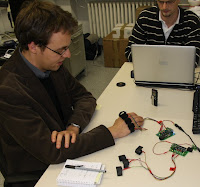Kategorie: Uncategorized
Light themes – cool idea but with usability flaws
New project on ambient visualization – kick-off meeting in Munich
We met in Munich at Docomo Euro Labs to start a new project that is related to context and ambient visualizations. And everyone already got bunnies 😉
Related to this there is a large and very interesting project: IYOUIT. Besides other things it can record and share your context – if you have a Nokia series 60 phone you should try it out. As far as I remember it was voted best mobile experience at mobile HCI 2008.
Random Links, toys and free location data
Over the last day I have learned about some (more) interesting things out there – here are some to share with you:
- OpenGeoDB: http://opengeodb.hoppe-media.com is a database with locations in Germany and an open API
- A community effort to create an open map: http://www.openstreetmap.org/
- publishing you travels to others: http://www.dopplr.com
- Ubfunckeys: USB connected strange toy, www.ubfunkeys.com
- A communicative rabbit: http://www.nabaztag.com/
Tactile interfaces, Visit from Gordon Bolduan
One Ez430-F2013 for each student in DSD
Enrico Rukzio visits our Lab
 Enrico Rukzio (my first PhD from Munich, now lecturer in Lancaster) visited our Lab. He was make a small tour of Germany (Münster, Essen, Oldenburg). In the user interface engineering class Enrico showed some on his current work on mobile interaction, in particular mobile projectors and NFC tags. After the presentation we wondered how long it will take till kids on the train will play with mobile projections 😉
Enrico Rukzio (my first PhD from Munich, now lecturer in Lancaster) visited our Lab. He was make a small tour of Germany (Münster, Essen, Oldenburg). In the user interface engineering class Enrico showed some on his current work on mobile interaction, in particular mobile projectors and NFC tags. After the presentation we wondered how long it will take till kids on the train will play with mobile projections 😉
Biometrics will come, who will care about privacy
Will we have face-2-face PC meetings in the future?
Christmas market in Essen
 Going to Christmas market is in Germany a tradition – and obviously our group went, too 😉
Going to Christmas market is in Germany a tradition – and obviously our group went, too 😉
It is interesting that most of us had time for this „appointment“ with only two days notice – usually it takes us weeks to find a date for a meeting and so far we did not find a date for a strategy meeting in the near future. Perhaps offering Glühwein (that is what you drink at Christmas markets) would help…
The quality of photos taken with a mobile phone is in difficult context (e.g. night, lights around) still not satisfactory (even with 5MP, downscaling, and image enhancing).








